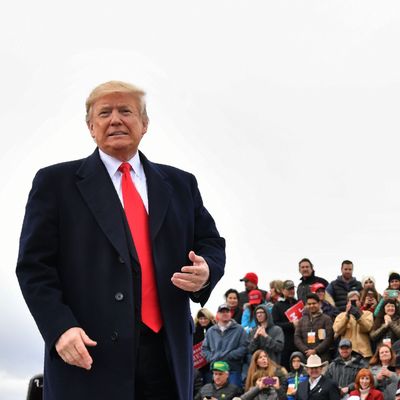
Donald Trump’s approval rating is about as steady as his Twitter feed is volatile. Over the past two years, the president’s favorability has fluctuated a bit within a narrow band. But none of the White House’s legislative failures, indicted ex-officials, flirtations with white nationalists, or historic abuses of power have durably moved Trump’s approval rating below 38 percent. And none of the president’s policy victories — nor the lowest unemployment rate in five decades — has been sufficient to push his favorability above 43 percent for more than an instant.
Assuming Trump retains his economic tailwinds, his approval rating looks just high enough to give him a narrow advantage in 2020.
But just because Trump’s approval rating has been essentially stable doesn’t necessarily mean that his coalition has been. Perhaps Trump has retained the support of (roughly) the same 42-ish percent of the American public throughout his time in office. Or perhaps he has compensated for significant losses with some demographics by gaining ground with others.
This isn’t an idle question. Trump owed his 2016 victory to the remarkable efficiency of his coalition. His 46 percent of the vote bought him a comfortable Electoral College majority because it was comprised disproportionately of non-college-educated white voters who are overrepresented in the Midwest’s key battleground states. Trade 100,000 of the mogul’s votes from blue-collar whites in Pennsylvania, Michigan, and Wisconsin for 100,000 of Clinton’s votes in the affluent suburbs of deep-blue states and the Trump presidency doesn’t happen.
Happily for Democrats, a new study suggests that Trump has, in fact, been making such a trade over his first two years in office.
The Democracy Fund’s Voter Study Group tracks the evolving views of thousands of voters who were first interviewed in 2011. To keep their survey sample nationally representative, VSG has added new voters into the mix, but the repeat interviewees still offer a gauge of how various categories of voters are changing with the times.
In its latest report, the VSG illuminates one critical shift hiding beneath Trump’s sturdy support: He has lost significant ground with Obama-to-Trump voters. In the project’s 2016 survey, 85 percent of such voters held a “favorable view of the president.” In its latest one, that figure fell to 66 percent. That may not sound like a lot, but, as we’ve observed, it won’t necessarily take a lot to change the course of history.
“Even small movement among these voters — who represented 9 percent of voters in 2016 — may prove significant heading into the 2020 presidential election,” the VSG’s research director Robert Griffin writes in the report. “Obama-Trump voters are also disproportionately white, non-college educated and, as a result, are likely to be well distributed geographically for the purpose of electoral impact.”
Meanwhile, Trump’s standing seems to have improved among NeverTrump Republicans — defined as Romney voters who went third party in 2016 — although this fraction of the electorate is so small that its modestly shifting views do not cross the threshold of statistical significance.
The report also appears to confirm that there is a hard ceiling on Trump’s support. Only 49 percent of voters have ever approved of Trump’s performance at any time since he took office. Which means that even if “Trump was able to regain a favorable rating from every American who had previously offered a positive opinion of him in the last two years, this would still only represent about half of Americans.”
Finally, the report provides a (highly limited) form of evidence that the electorate’s most ambivalent voters could opt for change in 2020: The vast majority of Americans — including most independents and Republicans — “are more likely to report negative emotions when they think about politics” now than they were before Trump’s election. Roughly three-quarters of the public say that they “feel disgusted” when they think about their nation’s politics.
All else being equal, that seems like an undesirable state of affairs for the incumbent.






























